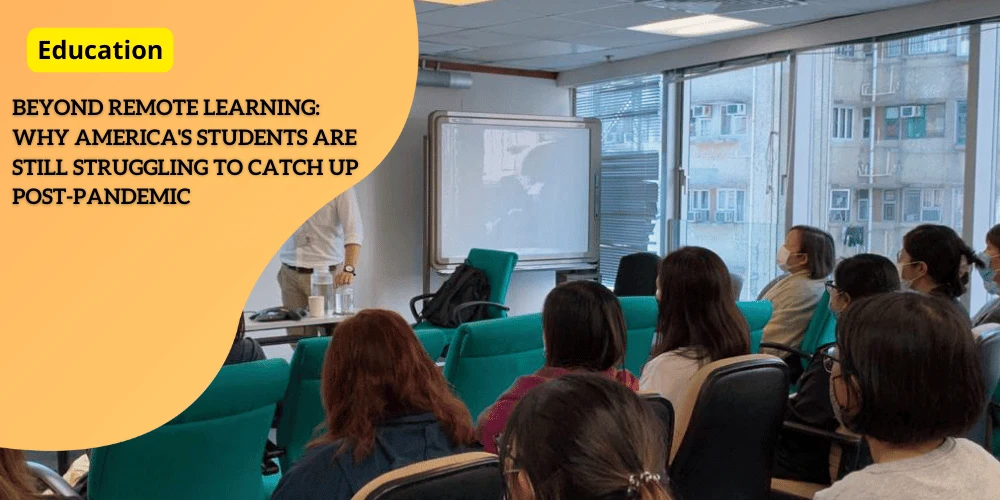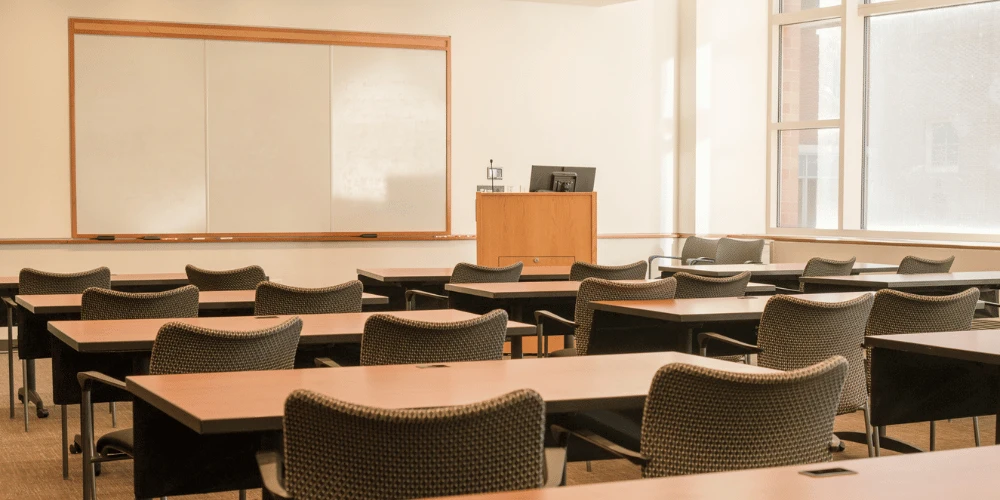Beyond Remote Learning: Why America’s Students Are Still Struggling to Catch Up Post-Pandemic

Anúncios
The Post-Pandemic Academic Landscape
Decline in Student Test Scores
Ever since the disruptions caused by the pandemic, there’s been an alarming decline in student test scores across the nation.
The U.S. Department of Education released recent data highlighting this concerning trend.
Anúncios
Students, particularly those who were already struggling, have fallen further behind their peers.
The gap between the highest and lowest performing students in critical subjects like math and reading has widened significantly.
Anúncios
Reading Levels Below Pre-Pandemic Standards
A sobering detail from the Department of Education’s findings is that fourth and eighth graders are now testing below pre-pandemic levels in reading.
This issue is compounded by the pre-existing literacy crisis; children are less enthusiastic about reading and are facing changes in teaching methods due to the digital age.
Teaching writing, in particular, has had to adapt, often in ways that may not be beneficial for student engagement and comprehension.
Urgency in Addressing Learning Recovery
Experts and education leaders are raising alarms and calling for urgent measures to rectify this situation.
As Tequilla Brownie, CEO of TNTP, suggests, there is a critical need to identify our previous missteps and adjust strategies accordingly to improve student outcomes, especially for those at risk of sliding into poverty due to inadequate literacy skills.
This declining trajectory in student performance and the widening achievement gap call for well-crafted, evidence-based strategies that ensure all students receive the quality education they deserve.
The Growing Literacy Crisis
Amid falling post-pandemic academic performance, one of the most pressing issues is the growing literacy crisis.
The recent decline in reading enthusiasm among students is alarming.
Children today are not as excited about reading as they once were, contributing to poorer literacy outcomes.
This trend has significant long-term implications.
Changes in Teaching Methods
The digital age has brought about substantial changes in how educators teach writing.
As children become more adept at digital communication, traditional writing skills have taken a back seat.
With increased reliance on digital tools, the foundational elements of writing are often overlooked, resulting in students not achieving the literacy levels expected at their grade levels.
The Impact of Poverty on Literacy
Low-scoring students from impoverished backgrounds are particularly vulnerable.
These students are at an increased risk of remaining in poverty due to their inadequate reading skills.
Without the ability to read proficiently, their opportunities for academic and economic advancement are severely limited.
Peggy Carr, Commissioner of the National Center for Education Statistics, and Adeola Whitney, CEO of Reading Partners, emphasized the critical need to view reading as a civil right that should be accessible to all students.
Ensuring equitable access to literacy education is vital for breaking the cycle of poverty and improving the future prospects of these children.
An Urgent Call for Action
Education stakeholders are sounding the alarm.
Many are calling for national leaders and education officials to swiftly address the literacy crisis.
Learning from past missteps and implementing effective solutions is crucial.
While temporary COVID-relief funding has expired, the urgency to find sustainable solutions remains.
Moving forward, it is essential to develop strategies to rebuild literacy proficiency and close the achievement gap.
Focusing on evidence-based methods and resources will be key in addressing these challenges.
The Persistent Attendance Problem
Consequences of Increased Absenteeism
Five years ago, the challenges of remote learning were just beginning.
Now, despite some improvements, America’s children—especially those who performed poorly—are far from their pre-pandemic academic standards.
The pandemic has exacerbated student absenteeism, creating dire consequences for the educational system.
Chronic absenteeism has been a growing concern, with rates increasing between 2018 and 2023 due to pandemic-related setbacks.
The American Enterprise Institute’s analysis highlights that chronic absenteeism involves students missing 10% or more days of the school year.
The data shows that students’ absenteeism remains a significant problem, with low-performing students more prone to missing school compared to their peers.

Impact on Low-Performing Students
Students who are already struggling academically are disproportionately affected by absenteeism.
Missing school not only impacts their current academic performance but also sets them back further, making it harder to catch up with their peers.
This cycle of falling behind and missing school creates a loop of continuous academic struggle and disengagement.
For instance, Peggy Carr from the National Center for Education Statistics notes that despite a slight decline in absenteeism since the 2022 assessment, it has yet to return to pre-pandemic levels.
The longer these students stay out of school, the more significant the gaps in their knowledge become, which perpetuates the widening achievement gap already observed between the highest and lowest performers.
The Ripple Effect on School Communities
Absenteeism doesn’t just affect individual students; it impacts the entire school community.
When a significant number of students are frequently absent, it can disrupt classroom dynamics, hinder the progress of ongoing lessons, and place additional strain on teachers who must accommodate varying levels of student presence and preparedness.
It destabilizes the learning environment, making it challenging for teachers to maintain continuity and structure.
The persistent absenteeism also affects school funding, as many funding models base their allocations on attendance rates.
Therefore, schools with higher absenteeism rates often receive less funding, reducing their ability to provide necessary resources and support to all students, further exacerbating the educational inequities.
The Call for Immediate Action
As federal emergency funds are now depleted, it’s more crucial than ever for policy and educational leaders to allocate resources judiciously to combat chronic absenteeism, scale high-dosage tutoring, and expand instructional time through extended school days and summer programming.
As Lindsay Dworkin from the education assessment company NWEA emphasizes, if students aren’t in school, they can’t learn.
Peggy Carr encapsulates this urgency, stating that the real challenge lies in re-engaging students and keeping them in school consistently.
It’s not just about getting students back into classrooms; it’s about ensuring they stay engaged and motivated once they’re there.
To tackle absenteeism effectively, schools need support from the entire community—including parents, local organizations, and policy-makers.
Transitioning from attendance issues, it’s essential to consider how the sizeable federal funding was utilized and what future steps can be taken to ensure a comprehensive recovery for students and schools alike.
Federal Funding and Recovery Efforts
The Troubling Impact of COVID-Relief Funding
Despite the U.S. government allocating a substantial $189.5 billion in COVID-relief funding through the Elementary and Secondary School Emergency Relief Fund (ESSER), the anticipated learning recovery has fallen short.
Many students, particularly those from disadvantaged backgrounds, remained significantly behind academically.
The intent of this emergency funding was to rapidly accelerate student learning; however, many education stakeholders argue that the outcome did not live up to expectations.
Keri Rodrigues, President of the National Parents Union, characterized the recent test results as a “national disgrace,” highlighting the alarming discrepancy between the massive federal investment and the dismal educational outcomes.
Calls for greater scrutiny into how schools utilized these funds have intensified, prompting suggestions for congressional investigations.
Expiration of Temporary Funding
With the expiration of this temporary funding, there’s a growing urgency for innovative and effective solutions.
The depletion of these financial resources places immense pressure on policymakers and education leaders to identify and prioritize sustainable, evidence-based strategies.
Lindsay Dworkin from the NWEA emphasizes that with dwindling resources, it’s crucial to focus on measures proven to enhance educational outcomes, such as combating chronic absenteeism and implementing high-dosage tutoring programs.
Exploring New Solutions
The pressing need for a comprehensive national education strategy has never been more evident.
Education leaders are advocating for:
| 🎯 Strategy | 📌 Description |
|---|---|
| ⏳ Extending Learning Time | Enhancing school days and offering summer programs to provide students with more learning opportunities. |
| 📖 High-Quality Educational Materials | Providing resources tailored to meet the diverse learning needs of students, ensuring accessibility and engagement. |
| 🎓 High-Dosage Tutoring | Offering personalized support through intensive tutoring sessions to help struggling students catch up. |
These initiatives represent viable pathways to not only address the current educational shortcomings but also to build a more resilient and equitable education system for the future.
Transitioning away from the reliance on temporary funds requires a concerted effort from the entire education community, including parents, teachers, and policymakers, to ensure that every student has the opportunity to succeed academically.
Moving Forward: Proposed Solutions
As we look toward solving the post-pandemic education crisis, implementing evidence-based strategies is key.
Drawing from research and successful case studies, these solutions emphasize tailored support and systemic changes to address learning disparities.
High-Dosage Tutoring
One proven method is high-dosage tutoring, which involves intensive, small-group instruction multiple times a week.
This personalized attention can help students grasp difficult concepts and catch up to their peers.
High-dosage tutoring is particularly effective for students from disadvantaged backgrounds who suffered the most during the pandemic.
Comprehensive National Education Strategy
Another critical step is devising a comprehensive national education strategy.
This would involve setting clear, actionable goals for all states and districts to follow, ensuring consistency and equity in education quality.
A national strategy would also facilitate sharing resources, best practices, and funding more efficiently, helping all students benefit regardless of location.
Extended Learning Time
Extending learning time is another powerful tool to accelerate student progress.
This can include lengthening the school day, adding days to the academic year, or offering robust summer programs.
Additional time allows for more in-depth lessons, enrichment activities, and the reinforcement of key concepts, helping to mitigate the learning loss experienced during the pandemic.
Quality Educational Materials
Lastly, focusing on providing quality educational materials is essential.
High-quality, engaging, and culturally relevant resources can make a significant difference in student learning outcomes.
These materials should be aligned with evidence-based curricula and teaching practices to ensure they support effective learning and teaching.
By implementing these solutions, we can create a more resilient and equitable education system capable of addressing the challenges exacerbated by the pandemic.







